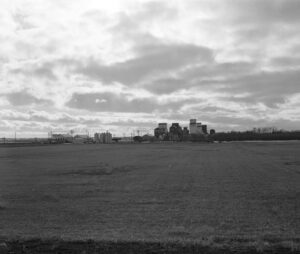The Cummings in Indian Head
Beginning in 1951, social biologist Elaine Cumming and psychiatrist John Cumming, a married couple, led a mental health education experiment in Indian Head, Saskatchewan. The Cummings worked in the Psychiatric Service Branch (PSB) of the provincial Department of Public Health at the time and the idea for the project arose from discussions between the PSB and the Canadian Mental Health Association about research that would support deinstitutionalization and related policies. The Commonwealth Fund, an American philanthropic organization with a specific interest in mental hygiene, backed the study financially.

The project sought to determine whether negative attitudes toward mental illness could be changed through commonly used educational means, including newspaper articles and advertisements, pamphlets and booklets in the local library, study groups, speaking engagements, debates, films and radio. Although similar instructional activities had been carried out elsewhere, none were as far-reaching and concentrated as in Indian Head.
Indian Head (given the pseudonym “Blackfoot”) was chosen because of its proximity to Regina in southeast Saskatchewan where the PSB headquarters was situated. Another key reason was that its population numbered only 1,500. This relatively small size meant that the educational program could reach everyone in town and that it was possible to survey all of the adults. The town was English-speaking, largely white and comparatively wealthy, boasting a federal Experimental Farm and a Forest Nursery Station. The Cummings perceived the settlement to be largely conservative and “less progressive” than other communities in the province. Yet, this fact made Indian Head even more attractive to them because they believed that if they could change attitudes here, they could change them anywhere.


Interviews and a survey of attitudes were conducted with local townspeople before and after the experiment in order to measure its effectiveness. Residents of the town of Moosomin, located in the same southeast section of the province, were used as a control group (the town was given the pseudonym “Deerville”). Unfortunately, not only did results indicate that attitudes remained unchanged, but in fact the town appeared to close ranks against the Cummings and their team. Near the end of the experiment the researchers felt that the citizens of Indian Head had become cold and withdrawn, even hostile, toward them. Eventually, the mayor told them to leave town.

The Cummings wrote about this study in the book titled Closed Ranks: An Experiment in Mental Health Education. Published by Harvard University Press in 1957, it contained a sophisticated sociological model to explain their findings. Remaining in print for 25 years, the volume is still considered a landmark study in mental health education and anti-stigma campaigning.
Elaine and John each became very successful researchers and policy-makers in both Canada and the United States. However, because of the negative findings, their research in small town Saskatchewan delayed plans for deinstitionalization in the province and contributed to a temporary decline in mental health education campaigns more broadly.
